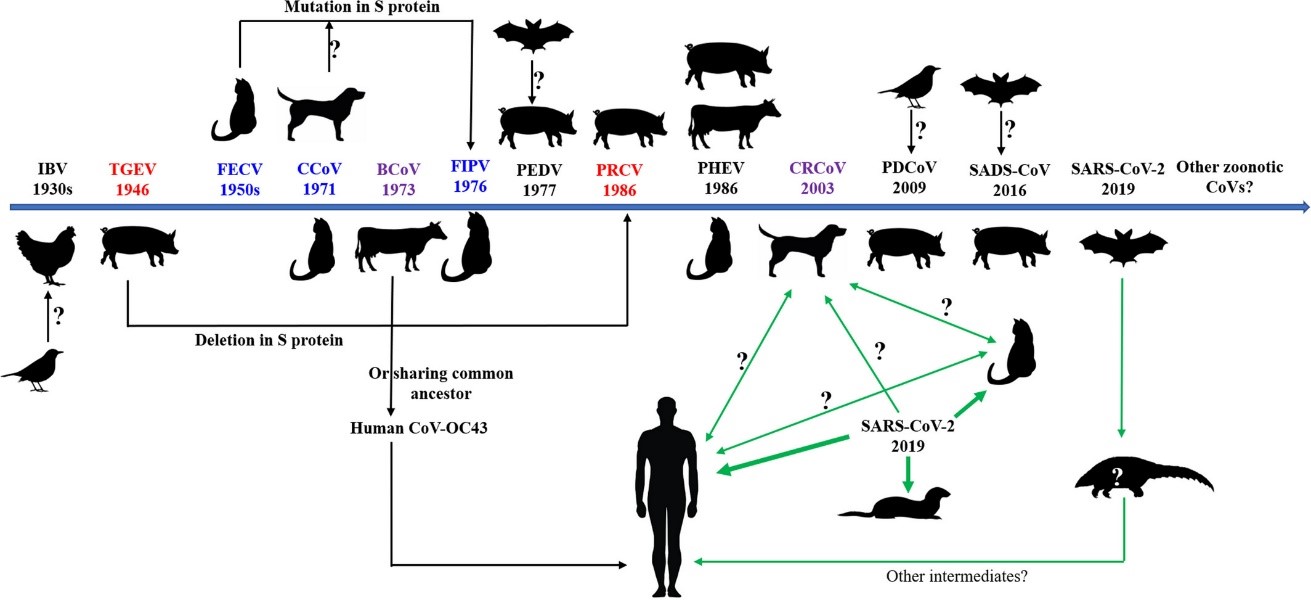CASS Published Recent Progress in Animal Coronavirus
Recently, researchers from Institute of Animal Sciences, Chinese Academy of Agricultural Sciences (CAAS) have published their recent work on progress in animal coronavirus and SARS-CoV-2 in Transboundary and Emerging Diseases, a prestigious journal in the area of veterinary medicine.
Since the outbreak in December, 2019, COVID-19 has caused great damages to both economy and public health worldwide. Although numerous discoveries are constantly reported every day, many aspects about this virus are still largely unknown, e.g. the natural reservoir and intermediate hosts of the virus, the transmission chain of this virus, the role of animals during the viral cross-species transmission, etc. Pet disease prevention and control innovation team took great research advantages, in collaboration with experts from China and abroad, and wrote this paper together to illustrate the potentially complex relationship between animal coronavirus and SARS-CoV-2.
In this study, researchers comprehensively reviewed the current research progress about animal coronaviruses and SARS-CoV-2 for their emergence, transmission, zoonotic potential, alteration of tissue/host tropism, evolution, and surveillance. As have discussed in this paper, this invader virus may have started targeting various organs in humans, and such changes have already been observed from other animal CoVs. Considering the high mutation rates and recombination events of these viruses, whether SARS-CoV-2 will further “fuse” with other CoVs of wild animals, livestock, or pets, was also discussed in this paper. In the end, the authors appealed that an appropriate monitoring system should be deployed for different species of hosts, especially cats and pigs, to avoid emergence of recombination events in a potential “mixing vessel”. Certainly, as a global pandemic with many unexplored mysteries, the effective control of COVID-19 can only be made through worldwide efforts and collaboration. This study provides valuable guidance for control of COVID-19 and preventative strategies for possible future outbreaks of zoonotic coronavirus from the perspectives of veterinarians.
Dr. Zhang Guangzhi from pet disease prevention and control innovation team is the first author of this work, and the correspondent author is Prof. Cui Shangjin. This work is funded by Agricultural Science and Technology Innovation Program (ASTIP-IAS15).
More details can be found in the link:
http://onlinelibrary.wiley.com/doi/10.1111/tbed.13791

(Description of research figure:)
Figure 1. Timelines of the emergence of animal CoVs with significant impact on farm animals, pets, and humans. Arrow directions stand for the gene source or gene exchange direction. Animals locating vertically at individual CoV are viral hosts. CoVs in the same color (red, green, purple) indicate that they have close relationship either gene exchange or sharing common ancestors. Blue line stands for the possible transmission route of SARS-CoV-2 between hosts. Thick lines strand for relative strength of infectivity.
By Zhang Guangzhi (zhangguangzhi @caas.cn)
-
 Apr 18, 2024Opening Ceremony of the Training Workshop on Wheat Head Scab Resistance Breeding and Pest Control in Africa Held in CAAS
Apr 18, 2024Opening Ceremony of the Training Workshop on Wheat Head Scab Resistance Breeding and Pest Control in Africa Held in CAAS -
 Apr 03, 2024IPPCAAS Co-organized the Training Workshop on Management and Application of Biopesticides in Nepal
Apr 03, 2024IPPCAAS Co-organized the Training Workshop on Management and Application of Biopesticides in Nepal -
 Mar 28, 2024Delegation from the School of Agriculture and Food Science of University College Dublin, Ireland Visit to IAS, CAAS
Mar 28, 2024Delegation from the School of Agriculture and Food Science of University College Dublin, Ireland Visit to IAS, CAAS -
 Mar 25, 2024Director of World Food Prize Foundation visited GSCAAS
Mar 25, 2024Director of World Food Prize Foundation visited GSCAAS -
 Mar 20, 2024Institute of Crop Sciences (ICS) and Syngenta Group Global Seeds Advance Collaborative Research in the Seed Industry
Mar 20, 2024Institute of Crop Sciences (ICS) and Syngenta Group Global Seeds Advance Collaborative Research in the Seed Industry
